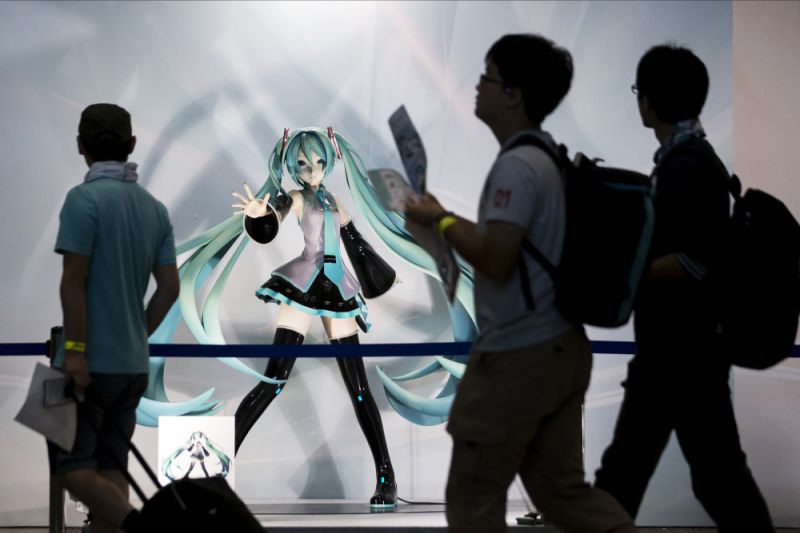
(Bloomberg) — Kizuna Ai, the most popular streamer in Japan, is an anatomically exaggerated, perpetually adolescent girl in frilly thigh-high socks and a pink hair ribbon. She’s also an entirely virtual character, given life by the actions and voice of an invisible actress.
In the home of anime and “Ghost in the Shell” futurism, millions now follow Kizuna Ai online, and that success has spawned thousands of copycat acts and a cottage industry catering to so-called virtual YouTubers, or VTubers. Defying the Western streamer blueprint of young male gamers like PewDiePie and Ninja, Japan has invented a new class of streaming star that’s equal parts digital avatar and interactive anime.
“What separates VTubers from regular anime characters is that you can believe they actually exist,” said Takeshi Osaka, founder of Activ8 Inc., the Tokyo-based company behind Kizuna Ai. “That presence is an important part of what makes them so appealing.”
Sidestepping the labor-intensive and time-consuming process of traditional animation — ill-suited to the fast-paced world of YouTube content — Activ8 uses Hollywood-grade motion capture equipment to crank out music videos, skits and game streams just about every day for more than 4 million subscribers.
The technology allows Kizuna to interact with fans in real time at exhibitions, give interviews on live TV and perform in concerts. It’s a virtual influencer that can patronize real-world events.
While Activ8 doesn’t disclose technical details, its product is an almost seamless combination of lifelike movements, gestures and facial expressions, all of which contribute to the suspension of disbelief.
“The innovation here is in how they combine real-time 3D computer graphics, motion capture and video streaming sites like YouTube to create two-way interactions with audiences,” said Eiji Araki, a senior vice president at Gree Inc. who heads a division specializing in VTubers.
Kizuna Ai debuted on YouTube in December 2016 and was responsible for coining the term “VTuber.” The technology that opened the door for its many imitators arrived that same year, in the form of the first commercial virtual reality goggles. Designed to do precise head and hand tracking, the VR kits from Facebook Inc.’s Oculus and HTC Corp.’s Vive turned out to be perfect animation rigs for VTuber aspirants on a budget. With free-to-use animation engines and 3-D models from the likes of Unity Technologies, anyone could create a virtual puppet studio for cheap in their living room.
Virtual Beings Get Real With First Emmy From Hollywood
It’s no accident that VTubers found fertile ground in Japan. The country has a long history of user-generated content centered on anime, and performances by virtual idols like Hatsune Miku have drawn real-world crowds for more than a decade. While international audiences may prefer more photorealistic characters — which are more difficult to create and animate — their Japanese counterparts raised on comic book heroes have no problem with cartoonish looks.
The VTuber phenomenon has so far been almost exclusively Japanese, however its underlying technology and formula of combining popular culture with increased interactivity — and thus believability — are universal. And Activ8 already has ambitions to expand its VTuber portfolio beyond Japan.
While Japan’s global tech leadership may have faded since the days of the Walkman, its trendsetting habits remain strong in the gaming realm. Three out of four gaming consoles sold in the world today are made by Nintendo Co. and Sony Corp., while free-to-play mobile games are taking over the globe with monetization techniques pioneered by Japanese companies. And then there are globally beloved game series like Super Mario, Zelda, Monster Hunter and Pokémon. Anime, another major Japanese cultural export, is a $20 billion industry whose products range from Oscar-winning high-brow works by Hayao Miyazaki to action-packed light entertainment like “Battle Angel Alita,” which recently got a Hollywood remake. VTubers are a cross between these two Japanese pastimes.
Market researcher User Local Inc. estimates there are now over 9,000 VTuber channels. The most popular ones are produced by a handful of professional studios like Activ8, each managing dozens of characters. In the space of less than three years, virtual streamers have morphed from an obscure subculture to a big business. Kizuna Ai can now be found in ads for instant cup noodles and eye drops, appearing at local carrier SoftBank Corp.’s launch event and helping the Japan National Tourism Organization’s promo campaigns.
“There is no doubt that this will change the future of entertainment,” said Hironao Kunimitsu, the founder of Gumi Inc., an early investor in Activ8 and about 70 other VR startups. He cautions, however, that “for this type of content to resonate outside of Japan, it will have to be adapted to local tastes and sensibilities.”
For now, Japanese VTubers are taking the path of least resistance and exporting their characters to China’s large and underserved anime market. Activ8 earlier this year introduced a Chinese version of Kizuna Ai, changing its dress and voice, and now it has close to 820,000 followers on the country’s Bilibili video-sharing service.
Ultimate success for Activ8’s chief means making it into Hollywood, which is already a well-trodden path for Japanese gaming franchises like Resident Evil, Pokémon and Sonic the Hedgehog. Given the world’s appetite for Japanese culture, VTubers might not even have to dilute their product very much.
“I started this virtual entertainer business because I believe it can be done worldwide,” Osaka said. “Our goal is to become the next-generation Disney.”
To contact the reporters on this story: Pavel Alpeyev in Tokyo at [email protected];Yuki Furukawa in Tokyo at [email protected]
To contact the editors responsible for this story: Edwin Chan at [email protected], Vlad Savov, Colum Murphy
<p class="canvas-atom canvas-text Mb(1.0em) Mb(0)–sm Mt(0.8em)–sm" type="text" content="For more articles like this, please visit us at bloomberg.com” data-reactid=”41″>For more articles like this, please visit us at bloomberg.com
©2019 Bloomberg L.P.







